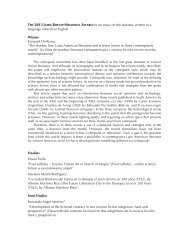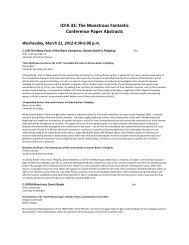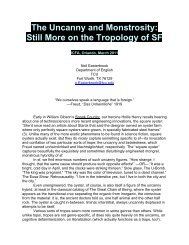The Monstrous Fantastic Conference Paper Abstracts - International ...
The Monstrous Fantastic Conference Paper Abstracts - International ...
The Monstrous Fantastic Conference Paper Abstracts - International ...
Create successful ePaper yourself
Turn your PDF publications into a flip-book with our unique Google optimized e-Paper software.
Charles Xavier and Erik Lehnsherr – and, most importantly, the ideological differences that ultimately separate them, Xavier in favor of humanand mutant peace and integration and Lehnsherr in support of the superiority and advancement of the mutants. Through the friendship thatthey do initially share and the differentiation between their life experiences and powers as mutants, the characters adopt and adaptFrankenstein’s negotiations of nature versus nurture, reason and passion, science and humanism, and the politics of difference. My paper willexplore how Xavier and Lehnsherr, along with other characters in the film, complicate the categories of human and monster, engagingcontemporary concerns about the post-human even as the setting calls upon the events of World War II and the Cold War, the evocation ofeugenics and nuclear mutation as potent an echo of Shelley’s novel as Lensherr’s bold statement. <strong>The</strong> mutant serves as a boundary-creaturebetween the human and the monster that reflect both self and other, fear and identification, and the film’s depiction of “a new future formankind: evolution” that is as steeped in the past as it is the fantastic. Reading Frankenstein’s textual and cultural influence in the film providesa useful and intriguing way to interrogate the importance and impact of the boundary-straddling, human/almost-human transitional categoryof the X-verse mutant.118. (H) <strong>The</strong> Last Werewolf: Interpretations of 21 st -Century Lycanthropy PalmChair: Jason HarrisFlorida Institute of Technology<strong>The</strong> Abject Body in Glen Duncan’s <strong>The</strong> Last Werewolf: Human or Werewolf?Sarah BentonUniversity of South FloridaIn a 2011 interview with culturemob.com, the author of <strong>The</strong> Last Werewolf, Glen Duncan, states: “Myths last as long as they express somethingfundamental – fear or desire – in the human psyche. <strong>The</strong> werewolf embodies both the fear of our bestial side and our desire to sink into it”(Duncan). Likewise, the onset of werewolf transformation brings Jacob Marlowe, the protagonist of <strong>The</strong> Last Werewolf, to the point where hemust negotiate an emerging identity involving his own humanity as an increasingly declining factor. Marlowe’s wolf self stays with him as a kindof ghost, haunting his limbs and human reactions, and essentially breaking down the border between human and monster. Marlowe’s werewolfself represents the loss of distinction between his human form and his monstrous self, thus embodying French critic Julia Kristeva’s theory ofthe abject. Kristeva defines one aspect of abjection as that which “disturbs identity, system, order. What does not respect borders, positions,rules. <strong>The</strong> in-between, the ambiguous, the composite” (13). Duncan’s werewolf externalizes the abject as a monstrous body that fragments thehuman self into embodying both the human and the monster simultaneously, therefore becoming a manifestation of Kristeva’s abject. Thispaper will discuss the werewolf as an abject body in the context of Glen Duncan’s <strong>The</strong> Last Werewolf and the ramifications of the monstrousand the human existing in the same corporeal form.<strong>Monstrous</strong> Reproduction: One Step Closer to HumanChelsey LucasNew College of FloridaWhere Werewolf and Zombie once were “born” of infection via bite, the novels <strong>The</strong> Last Werewolf by Glen Duncan (2011) and Breathers: AZombie’s Lament by Scott G. Browne (2009) introduce monstrous reproduction in a method that is one step closer to human: through the act ofbiological sexual intercourse. What this paper resolves to discuss is the impact of suggesting such likeness between the social definition of“human” versus that of “monster” by analyzing sex through the model of Freud’s Uncanny, and what it means that the creation, the birth itselfis a direct association between these dichotomies. Taking this most fundamental concept--the very start of life--in a sense attempts tohumanize the monsters; it advocates for a collective understanding, that “it’s been us all along” (Duncan 119). But what does it say of thepossibility of assimilation when the characters lose their children? In Duncan’s novel, not only does protagonist Jake murder his human wifeand unborn child, but he dies before the chance to know what becomes of his werewolf offspring who will, with luck, carry on the species. ForBrowne’s zombie, Andy, his undead lover and fetal child are burned to death before readers can know what a monster born of natural meanswill be like. Here, Jeffrey Cohen’s assertion that monsters are “a form suspended between forms that threaten to smash distinctions” (Cohen 6)becomes undeniably salient as fantastic literature progressively integrates modern human culture.Glen Duncan’s <strong>The</strong> Last Werewolf and the Problem of the Paul NaschyDouglas FordState College of FloridaGlen Duncan’s <strong>The</strong> Last Werewolf marks a significant moment in the canon of fantastic literature, for while most modern vampire literature candirectly or indirectly claim Dracula by Bram Stoker or, to a lesser extent, Carmilla by Sheridan Le Fanu, as their originative (or perhapsrestraining) foundation, writers of werewolf fiction have had no such obvious antecedent for their own works. Despite such notable novels likeGuy Endore’s <strong>The</strong> Werewolf of Paris (1933), Gerald Bliss’s <strong>The</strong> Door of the Unreal (1919), and Jessie Douglas Kerruish’s <strong>The</strong> Undying Monster(1922), as well as a rich body of folklore and legend, the werewolf canon has struggled to find its own text of consequence, a point of departureon which others can build. This stands as a crucial point because, even more so than other supernatural creatures, werewolves generally showobsession with the circumstances of their origin, whether from curse, pact with the devil, birth, or bite. This concern with origins becomesparamount in the narrative of <strong>The</strong> Last Werewolf, but Duncan sets his novel apart by intertwining the physical circumstances of Jake Marlowe’swerewolf origin with a self-reflexive preoccupation with finding, or ultimately becoming, the absent text of origin. This paper will locate andanalyze these concurrent threads in the novel by juxtaposing them with the series of Spanish films starring (and in many cases, written by) PaulNaschy as the doomed werewolf, Waldemar Daninsky. Each of Naschy’s films, beginning with <strong>The</strong> Mark of the Wolf Man (1968), depict a new,often conflicting origin for Daninsky’s curse, illustrating the fluid nature of a werewolf’s origin, as well as a “problem” that Duncan ultimatelystrives to untangle with an intentional misnomer: a “last” werewolf who may really mark something inceptive.





